America’s relationship with France predates our founding as a country. From the days of Benjamin Franklin and General Marquis de Lafayette to the modern day with Presidents Trump and Macron, U.S. and French leaders have long shared common values.
President Trump Calls the U.S.-France Relationship ‘Unbreakable.’ History Shows He’s Right.
America’s relationship with France predates our founding as a country. From the days of Benjamin Franklin and General Marquis de Lafayette to the modern day with Presidents Donald J. Trump and Emmanuel Macron, U.S. and French leaders have long shared common values on a range of economic and security-related issues.
President Trump and First Lady Melania Trump welcome the French President and his wife, Mrs. Brigitte Macron, to the White House on April 24. The occasion marks the first official State Visit under the Trump Administration, as well as the first State Visit from France since President Francois Hollande came to Washington in 2014.
The two couples will meet for a scenic tour of the monuments in our Nation’s capital Monday evening before the official visit begins. They will then travel to the home of President George Washington in Mount Vernon, Virginia, for a private dinner before participating in the State Arrival Ceremony on the White House South Lawn Tuesday morning.
To appreciate the importance of the visit, it is key to understand the rich history between France and the United States.
French settlers came to the American continent as early as the 1500s. When the American colonists were fighting for independence, France supported our Revolutionary War with military and economic aid from 1775 to 1781. French leaders also formally recognized our new Nation as early as 1778.
Some of America’s most prominent Founding Fathers—Benjamin Franklin, John Adams, and Thomas Jefferson—served as U.S. diplomats to France. French style was incorporated throughout early American art and architecture, including at the White House. While refurbishing the structure after the fire of 1814, President James Monroe ordered a suite of French furniture for what is now the Blue Room. And one of America’s icons, the Statue of Liberty, was a gift from France in 1886.
Much of our Nation’s modern-day relationship with France dates to World War II, including the post-war institutions that underpinned both the Western order and our ideological confrontation with communism. France and America were two of the original five permanent members of the United Nations Security Council. The countries are party to several of the same multilateral groups, including the North Atlantic Treaty Organization (NATO), G-7, and the Organization for Economic Cooperation and Development.
The two countries also enjoy a strong trade relationship:
France is America’s third-largest trade partner in Europe. When President Trump met with President Macron in Paris last year, the two leaders agreed to pursue a trading environment that was free and fair for workers in both countries.
“Both President Macron and I understand our responsibility to prioritize the interests of our countries and, at the same time, to be respectful of the world in which we live,” President Trump said. “The friendship between our two nations—and ourselves, I might add—is unbreakable.”
Some of America’s most prominent Founding Fathers—Benjamin Franklin, John Adams, and Thomas Jefferson—served as U.S. diplomats to France. French style was incorporated throughout early American art and architecture, including at the White House. While refurbishing the structure after the fire of 1814, President James Monroe ordered a suite of French furniture for what is now the Blue Room. And one of America’s icons, the Statue of Liberty, was a gift from France in 1886.
Much of our Nation’s modern-day relationship with France dates to World War II, including the post-war institutions that underpinned both the Western order and our ideological confrontation with communism. France and America were two of the original five permanent members of the United Nations Security Council. The countries are party to several of the same multilateral groups, including the North Atlantic Treaty Organization (NATO), G-7, and the Organization for Economic Cooperation and Development.
The two countries also enjoy a strong trade relationship:
France is America’s third-largest trade partner in Europe. When President Trump met with President Macron in Paris last year, the two leaders agreed to pursue a trading environment that was free and fair for workers in both countries.
“Both President Macron and I understand our responsibility to prioritize the interests of our countries and, at the same time, to be respectful of the world in which we live,” President Trump said. “The friendship between our two nations—and ourselves, I might add—is unbreakable.”
President Donald J. Trump And President Emmanuel Macron Continue To Build The Trans-Atlantic Alliance
« Ever since General Lafayette joined the American fight for independence, our fates and fortunes have been tied unequivocally together. » (President Donald J. Trump)
A long and enduring friendship:
President Trump is continuing the legacy of French-American cooperation that stretches back to America’s independence and working with President Macron to build the already strong ties between the United States and France.
• President Trump has made clear that the bond between the United States and France is unbreakable.
o The relationship between the two countries dates back to the days of the American Revolution, when thousands of French soldiers fought alongside American troops and provided crucial support in our fight for freedom and liberty.
• Presidents Trump and Macron have reaffirmed and strengthened the U.S.-France relationship. They have met in person and spoken on the phone numerous times.
o In September 2017, Presidents Trump and Macron met on the sidelines of the United Nations General Assembly in New York City.
o In July 2017, President Trump spent two days visiting with President Macron to commemorate Bastille Day and the entry of the United States into World War I.
o In May 2017, President Trump hosted President Macron at the official residence of the U.S. Ambassador to Belgium for a meeting before the NATO summit.
A Valued trade and investment partner: France was the first trade partner of our Republic and remains a major destination for U.S. exports and source of foreign investment in the United States.
• In 1778, the United States signed its first trade agreement after the Declaration of Independence with France, the U.S.-France Treaty of Amity and Commerce.
• Today, France is the third largest European trading partner of the United States and, including American and French affiliates, averages over $1 billion in commercial transactions with the United States every day.
o In 2017, the U.S. exported $19.3 billion in services to France, resulting in a $1.6 billion trade in services surplus.
o In 2017, the U.S. exported $33.6 billion in goods to France, and exported more than $5 billion in goods in just the first two months of 2018.
o In 2017, France was the 11th largest market for U.S. goods exports.
• The United States is the top destination for French foreign investment and, in 2016, more than $24.3 billion in French investment flowed into the United States.
• The United States is the largest foreign investor in France and, in 2016, total U.S. investment in the country stood at $78 billion.
• French investment supported 677,500 jobs in the United States in 2015.
A STRONG AND RELIABLE ALLY: The United States has worked closely with France to combat terror around the world and, most recently, confront Syrian President Bashar Al-Assad’s heinous chemical weapons attack.
• On April 13, 2018, President Trump joined with President Macron and United Kingdom Prime Minister Theresa May to launch punishing missile strikes against Assad’s chemical weapons infrastructure in response to the his use of chemical weapons against his own people.
• In 2018, the United States and France strengthened their partnership against WMDs, including efforts to prevent nuclear terrorism and enhance biodefense cooperation to combat biological threats.
• During the July 2017 press conference with President Trump in France, President Macron said that “when it comes to fighting terrorism, from day one I can say that we’ve seen eye to eye.”
• President Trump will strengthen coordination with President Macron on countering jihadist propaganda and continue to work with France on the fight against ISIS.
• France has been a key partner of the United States in the global campaign against ISIS:
o Carrying out air operations against the terrorist group in Iraq since September 2014 and in Syria since September 2015; and
o Committing tens of millions of dollars in humanitarian assistance to help rebuild Iraq and Syria after the defeat of ISIS.
• Following the President’s calls, French President Emmanuel Macron has committed to increasing French defense spending by 35 percent over the next eight years and meeting the 2 percent NATO defense spending commitment.
President Trump’s remarks came as he enjoyed the hospitality of President and Mrs. Macron in France for Bastille Day. Now, President Trump and the First Lady have an opportunity to welcome the Macrons to Washington and strengthen this enduring bond even further.
As President Trump and the First Lady prepare to welcome President and Mrs. Macron to Washington, a look back at other notable French visits to the United States:
- October 22, 1931: Prime Minister Pierre Laval, hosted by President Herbert Hoover
- August 22, 1945: Provisional President Charles de Gaulle, hosted by President Harry S. Truman
- March 28, 1951: President Vincent Auriol, hosted by President Harry S. Truman (at the Carlton Hotel due to White House renovations)
- April 22, 1960: President Charles de Gaulle, hosted by President Dwight D. Eisenhower
- February 24, 1970: President Georges Pompidou, hosted by President Richard M. Nixon
- May 17, 1976: President Valery Giscard d’Estaing, hosted by President Gerald R. Ford
- October 18, 1981: President Francois Mitterrand, hosted by President Ronald Reagan
- March 22, 1984: President Francois Mitterrand, hosted by President Ronald Reagan
- March 31, 1987: Prime Minister Jacques Chirac, hosted by President Ronald Reagan
- February 1, 1996: President Jacques Chirac, hosted by President William J. Clinton
- November 6, 2007: President Nicolas Sarkozy, hosted by President George W. Bush
- February 11, 2014: President Francois Hollande, hosted by President Barack Obama
State dinner photos from throughout History
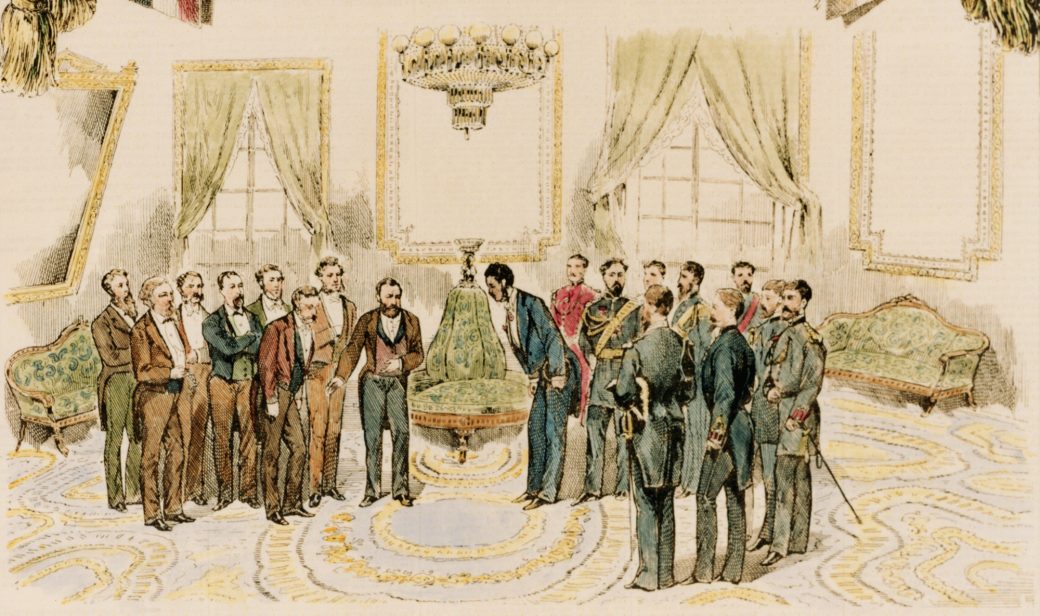
Engraving of King Kalakaua of Hawaii visiting President Ulysses S. Grant on December 12, 1874, in the Blue Room. (White House Historical Association)
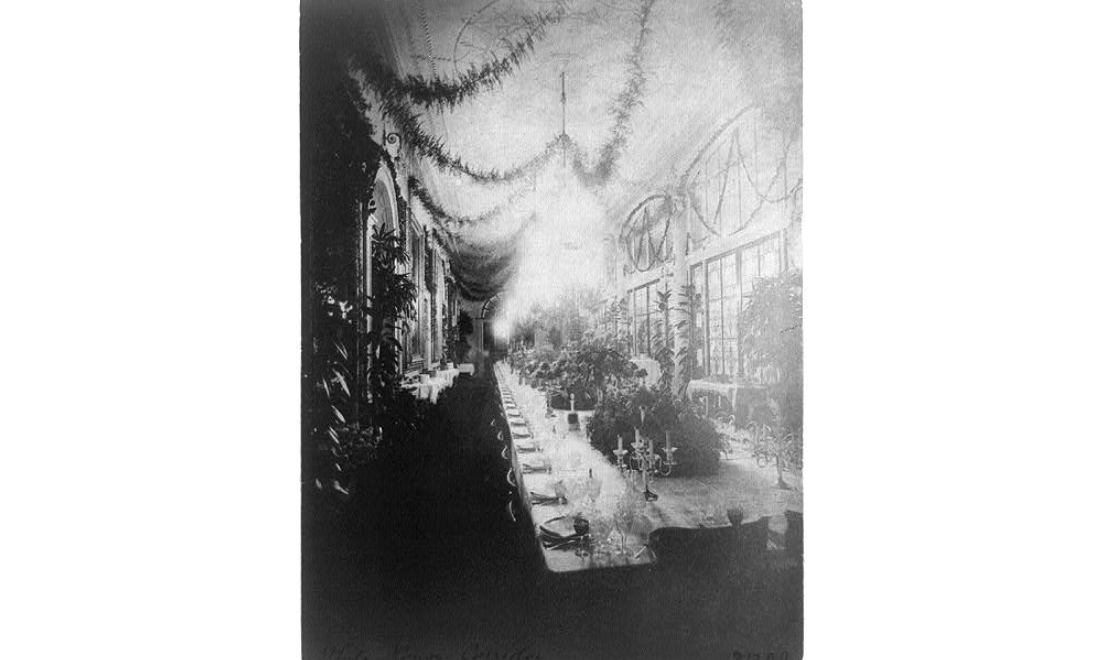
The long corridor used for a State Dinner 1898. (Library of Congress by Frances Benjamin Johnston)

The State Dinner table setting in the East Room of the White House for Prince Henry of Prussia on February 24, 1902. (Library of Congress by H.C. White Co.)

President Harry S. Truman, General Charles de Gaulle of France, and other military leaders saluting on the South Lawn, Aug. 22, 1945. (White House Historical Association by Abbie Rowe)
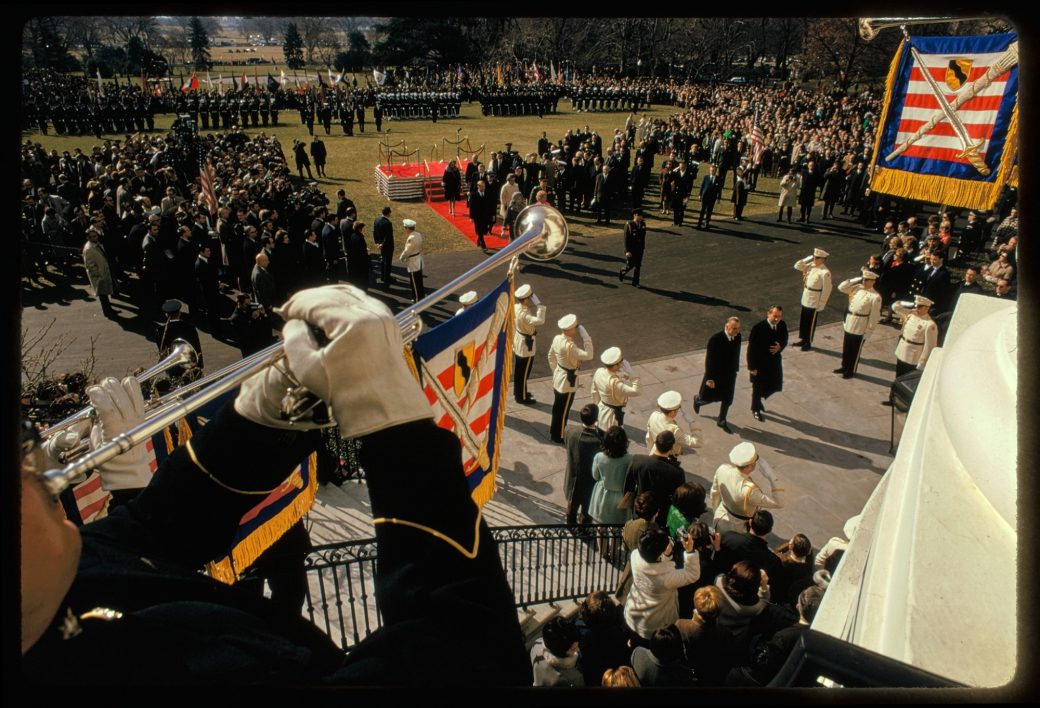
Arrival ceremony for President Georges Pompidou of France on February 24, 1970. (White House Historical Association by Joseph J. Scherschel)
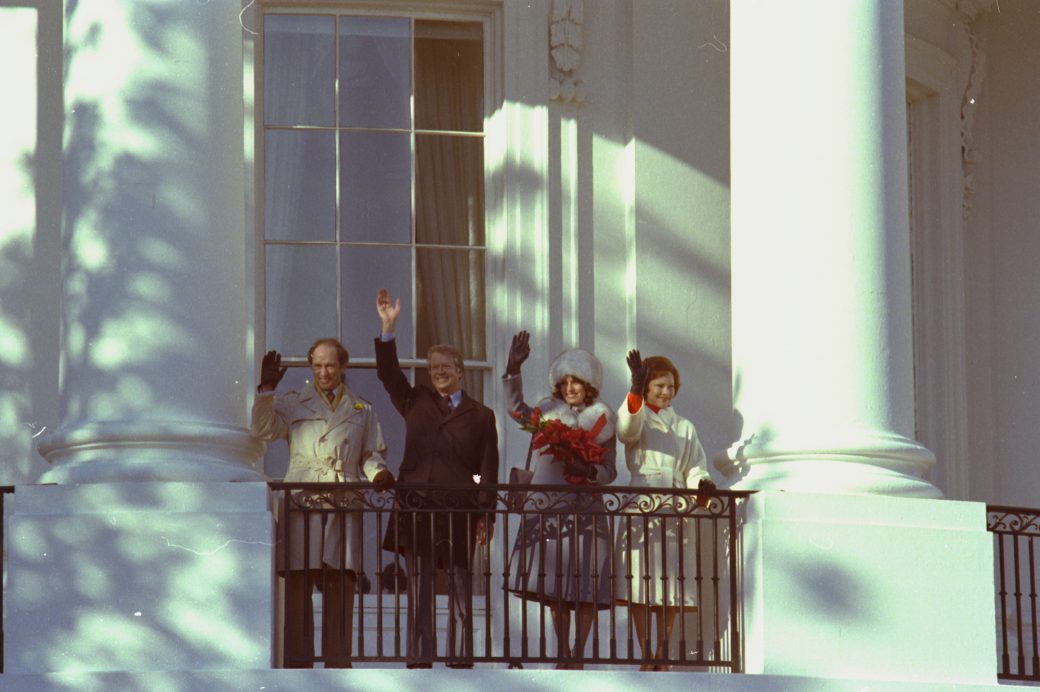
Prime Minister Pierre Trudeau of Canada, President Jimmy Carter, Margaret Trudeau, and First Lady Rosalynn Carter on the Truman Balcony at State Visit arrival ceremony, February 21, 1977. (White House Historical Association from Jimmy Carter Presidential Library)

President Ronald Reagan, First Lady Nancy Reagan, Prime Minister Lee Kuan Yew of Singapore, and Mrs. Lee stand on the North Portico of the White House on October 8, 1985. (White House Historical Association from Ronald Reagan Presidential Library)
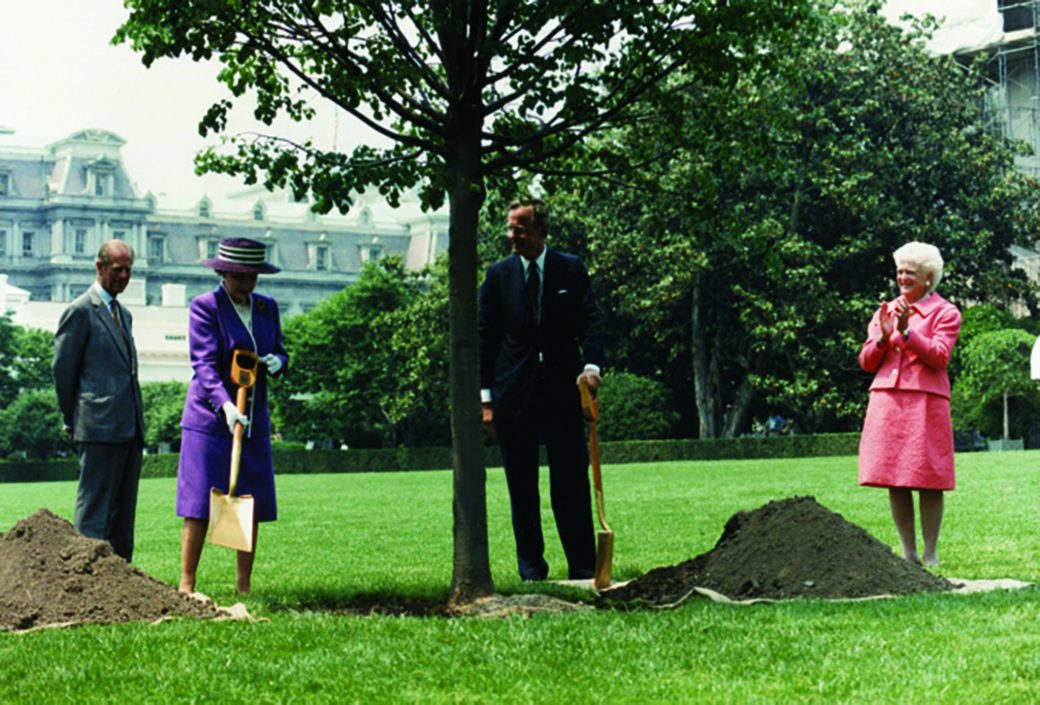
Queen Elizabeth II of Great Britain and President George H. W. Bush plant a little-leaf linden tree on the South Lawn of the White House Grounds in May 1991 during an official State Visit. She planted the tree to replace the one her father, King George VI, planted in 1937 that was lost due to a storm in September 1990. Prince Philip, Duke of Edinburgh, Queen Elizabeth’s husband, and First Lady Barbara Bush observe the ceremony from afar. (White House Historical Association from George Bush Presidential Library and Museum)
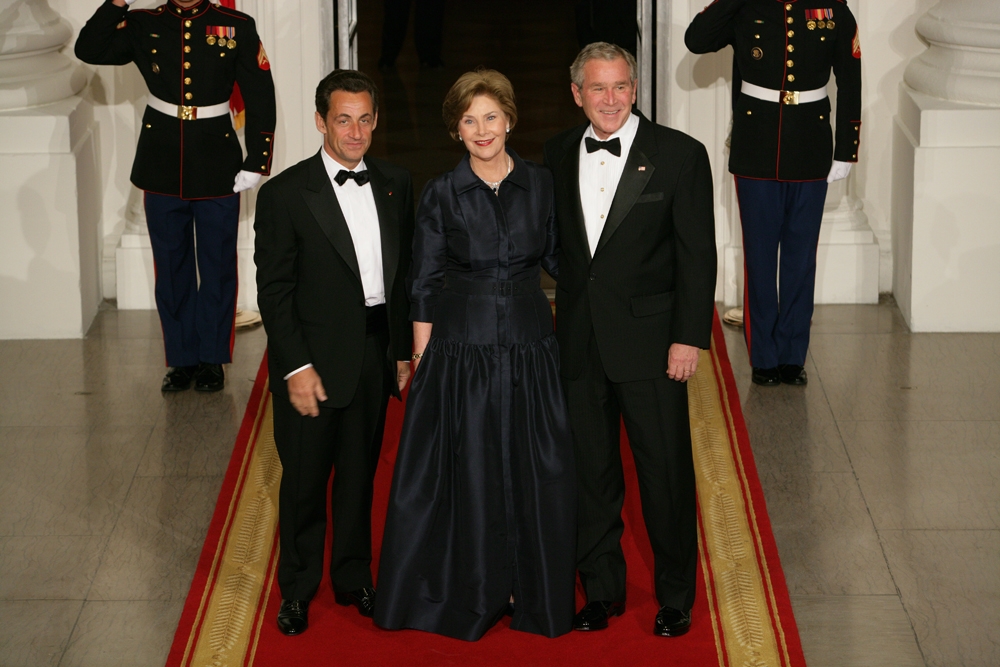
President George W. Bush and First Lady Laura Bush stand with President Nicolas Sarkozy of France on the North Portico of the White House after his arrival for a State Dinner on November 6, 2007. (White House Historical Association from George W. Bush Presidential Library and Museum).










